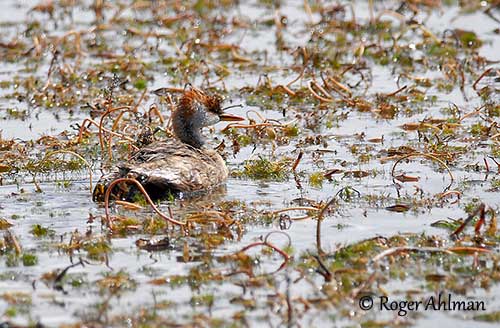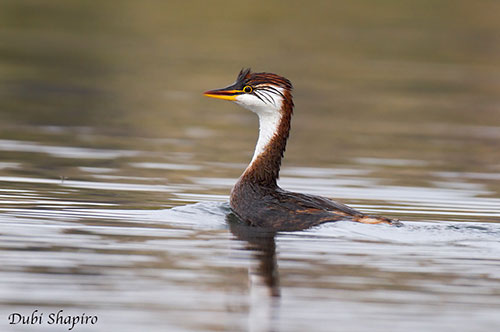
Fr: Grèbe microptère
Ang: Titicaca Grebe - Titicaca Flightless Grebe - Short-winged Grebe
All: Titikakataucher
Esp: Zampullín del Titicaca - Zambullidor del Titicaca
Ita: Svasso alicorte
Nd: Titicacafuut
Sd: titicacadopping
Photographers:
Roger Ahlman
Pbase Galleries Peru and Ecuador
Jean Michel Fenerole
Photos d’Oiseaux du monde
Patrick Ingremeau
TAMANDUA
Dubi Shapiro
Dubi Shapiro Photo Galleries & Dubi Shapiro's Pictures on IBC
Text by Nicole Bouglouan
Sources:
HANDBOOK OF THE BIRDS OF THE WORLD vol 1 by Josep del Hoyo-Andrew Elliot-Jordi Sargatal - Lynx Edicions - ISBN: 8487334105
BIRDS OF PERU by Thomas S. Schulenberg, Douglas F. Stotz, Daniel F. Lane, John P. O’Neill, Theodore A. Parker III – Princeton University Press 2007– ISBN: 978-0-691-13023-1
Wildlife of the World De DK – Editeur: Dorling Kindersley Ltd, 2015 – ISBN: 0241247144, 9780241247143 – 400 pages
The Titicaca Flightless Grebe Rollandia microptera population of Río Laka Jahuira, Bolivia
Neotropical Birds – Cornell Lab of Ornithology
Wikipedia, the free encyclopaedia
Titicaca Grebe
Rollandia microptera
Podicipediformes Order – Podicipedidae Family
INTRODUCTION:
The Titicaca Grebe is a flightless species found on Lake Titicaca and surrounding waterbodies at high elevation in Bolivia and Peru. This species does not fly because its habitat is suitable year-round, with large lakes and permanent food availability.
The Titicaca Grebe is an excellent diver and is often submerged under water while hunting for fish. Its diet consists almost exclusively of one type of fish of genus Orestias.
This species breeds solitary or sometimes in loose colonies, but it may occasionally breed co-operatively. It builds a typical floating platform and produces several broods per year.
The Titicaca Grebe is confined to freshwater lakes at high elevation. It is mainly threatened by the use of long gill-nets in lakes. The birds are frequently caught in these nets and drown. Human disturbance and boats affect the breeding success of the species.
The Titicaca Grebe is currently listed as Endangered, with a small, declining population.
DESCRIPTION OF THE BIRD:
Biometrics:
Length: 28-45 cm
Weight: 600-635 g
The Titicaca Grebe adult in breeding plumage has blackish-brown upperparts. On the upperwing, the primaries are paler grey-brown and the secondaries show a large amount of white.
On the underparts, chin, throat and a large part of foreneck are white. Flanks are dark, blackish-brown with variable amount of chestnut, whereas the rear of the flanks is chestnut. The belly is whitish and shows pale chestnut spotting, and the undertail-coverts are white. On the underwing, the coverts are whitish.

On the head, the crown is dark brown to blackish. We can see dark elongated feathers, blacker on forehead and lores. There are several narrow dark lines extending from the eye across the white ear-coverts and lower face.
Nape and upper hindneck are rufous-brown, but much darker on middle and lower hindneck, and also on lower foreneck to breast sides.
The heavy bill is orange-yellow with reddish to blackish cutting edges and blackish culmen. The eyes are dark brown, surrounded by narrow, yellow eyering. Legs and lobbed feet are orange-yellow to dark grey.
The Titicaca Grebe adult in non-breeding plumage is paler and duller with grey-brown upperparts. Below, the flanks show some amount of ochre-brown and whitish.
On the head, the crown is dusky to fulvous-brown, and we can see a narrow, whitish line at base of upper mandible and extending to the lores. Nape, hindneck and breast sides are duller brown to sandy-grey. The dark lines behind the eye are less distinct.
The bill is paler and more extensively yellow-orange.
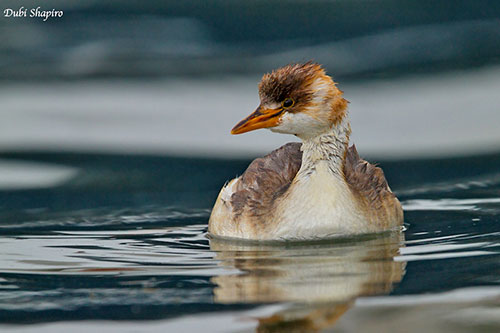
Male and female are similar.
The juvenile resembles non-breeding adult but it is duller and greyer with paler areas. Lower face, foreneck and underparts are whitish.
The bill is duller. Legs and feet are tinged greenish.
RANGE:
The Titicaca Grebe is endemic to Lake Titicaca and adjacent Lake Uru-Uru in SE Peru and W Bolivia, at 3,700/3,800 metres of elevation. This species is restricted to the Altiplano of Bolivia and Peru.
HABITAT:
The Titicaca Grebe frequents large lakes at high elevation in the Andes. It needs open waters with reedbeds and floating vegetation. It nests mainly among patches of bulrush (Scirpus totora) or floating waterweeds, with a good access to open water.
CALLS AND SONGS: SOUNDS BY XENO-CANTO
The Titicaca Grebe is very vocal but it also uses striking visual signals. The contact call is “gyak” and some louder “gyrrk” are given for advertisement. During the territorial disputes, they produce series of loud squeals, but a growing “hrrr” is given as threat.
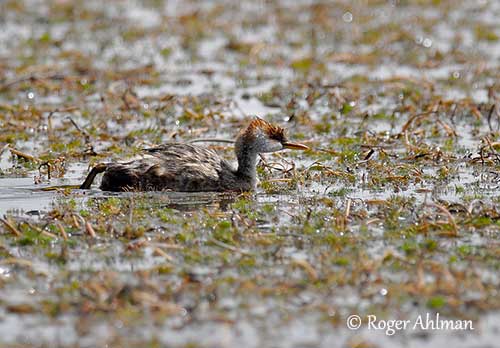
BEHAVIOUR IN THE WILD:
The Titicaca Grebe has a highly-specialised diet with 90-95% of the food consisting on pupfish (Orestias), a fish species found in lakes and rivers in the Andean highlands of South America. But it also consumes aquatic insects and arthropods.
It forages in relatively open, deep water. It is a very good diver and spends long time submerged under water while hunting for fish. It may sometimes peers from water surface. It usually forages far from shore in patches of submerged vegetation.
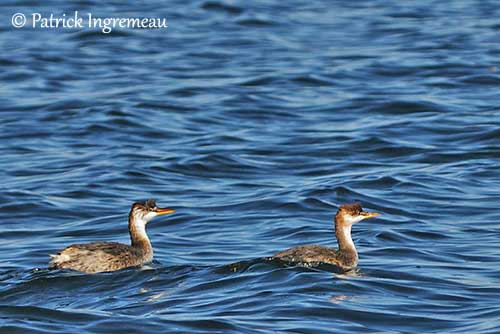
The Titicaca Grebe is territorial. It performs elaborate courtship displays often starting with several birds. The courtship is mainly vocal and often with duets.
This species appears to be social, but aggregating nesting probably occurs, due to the scarcity of suitable nesting habitats. They breed all year-round.
The Titicaca Grebe is flightless and sedentary.
However, it runs over water while performing active wingbeats, and despite its very small wings, it is able to cover considerable distances, especially when alarmed. It prefers to flee over water rather than reaching the vegetal cover.
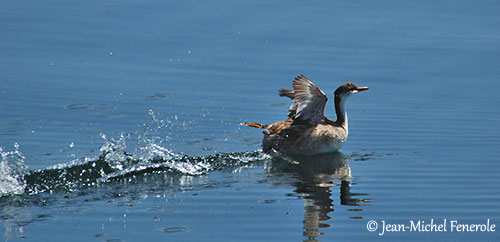
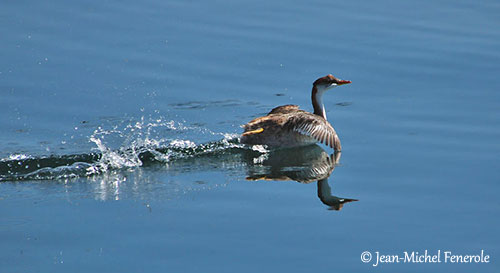
REPRODUCTION OF THIS SPECIES:
The Titicaca Grebe is able to breed all year-round, due to stable climate of Lake Titicaca.
This species produces several broods per year, with peak in November-December.
The Titicaca Grebe breeds solitary, occasionally in loose colonies, and sometimes co-operatively. In this case, large young of one brood may help to feed the chicks of later brood.
The nest is a typical floating platform made with vegetation.
The female lays 2 eggs (1-4), sometimes using the same nest for the following clutches. The chicks have grey down, paler underparts, and rufous and white stripes on head and neck. No more information.
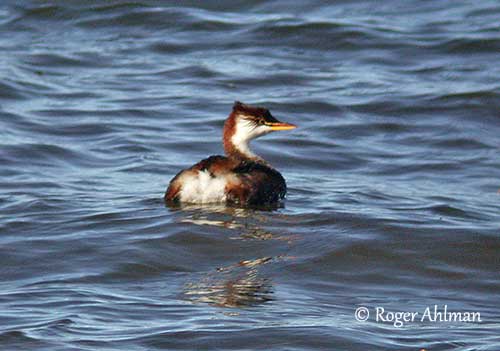
PROTECTION / THREATS / STATUS:
The Titicaca Grebe is heavily threatened by the increasing use of fishing nets with fine mesh. However, the introduction of other fish species has caused the disappearance of numerous native fish, involving the reduction of main prey availability. Natural fluctuations in water levels also impact the breeding success, and chemical contamination from the heavy metal mining industry in adjacent lakes also play a role in population decline.
Other threats such as hunting, eggs harvested for food, degradation of breeding habitat, increasing tourism and disturbance by boats also impact the breeding success.
The global population was estimated at 1,600 mature individuals in 2003, but the population is scattered on small adjacent lakes, at least seasonally, and more studies and estimations are required.
This population is rapidly declining due the threats previously described especially the continuous use of fishing nets.
The Titicaca Grebe is currently listed as Endangered.
